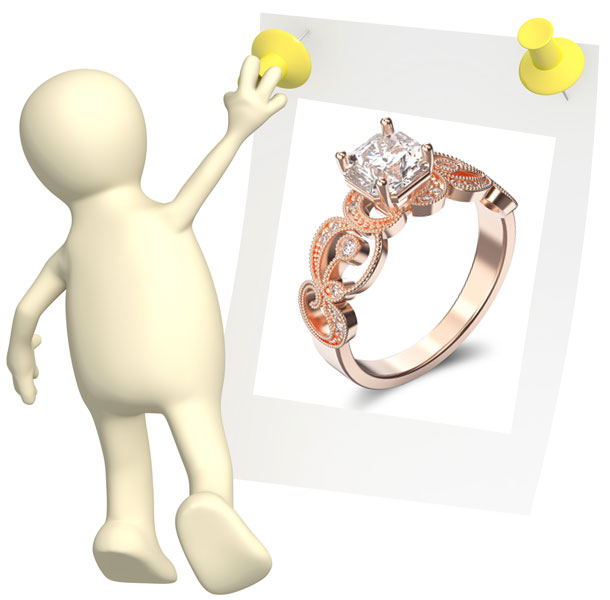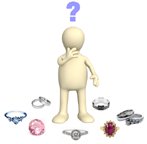How to Find History About my Ring?
by Alicia
(North Conway)
Hi. I have an engagement ring given to me by my husband – who got it from his mother, who got it from his great, great aunt. (No one’s sure where it came from before then). How would I look up information about this ring and find out how much it is worth?
The ring is a 3/4 carat diamond ring with 6 prongs holding the diamond in 14K gold. On the inside of the ring next to the 14K gold stamp it also has symbols or letters but I can’t make them out.
I’m just wondering how I can find out the history of the ring, where it was made, when it was made etc.
Thank-you very much for your time.

Hello Alicia,
To find out more about this engagement ring, some detective work is needed. Clues that can help you to zero in on the ring’s exact history include the stamps on the ring, the gold karat and - most importantly - the style of the ring.
To start with the 14K gold stamp on the ring and the type of gold carat the ring is made with:

The ring would most likely be from the United States or Canada, because England – and most other countries – uses a ‘C’ abbreviation to stand for ‘gold carat’ while the United States and Canada use a ‘K’ abbreviation to stand for ‘gold karat.’ So, a 14K stamp would indicate a United States or Canadian origin.
Secondly, the stamping process which identifies the type of gold used to make the ring (also known as hallmarking) was not a legal requirement in the U.S. until 1906 – so it is quite possible that the ring was made sometime after this date.
The use of 14 karat gold too was not widely in use until after the turn of the century, around the Art Nouveau period beginning in 1890. Before that time, rings were most often crafted out of 18K, 15K, 12K and 9K gold.
Periods of time when 14K gold was popularly used for crafting jewelry and rings include the Art Nouveau period (1890 to 1915), the Art Deco period (1915 to 1935) and the Retro period (1935 to 1945). Jewelry pieces defined by the Edwardian Era (1901 to 1910), which overlap the Art Nouveau period, were most often made out of platinum.
The style of the ring is a major clue that a professional antique jeweler/appraiser will use to estimate when the ring may have been made. All of these periods of time had very specific different types of styles and designs – it’s a bit like looking at clothes from the 50s, 60s or 70s and being able to identify when they were likely made based on their styles.
A professional jeweler may also be able to identify the stamps or letters on the inside of the ring – which could be hallmark stamps from the ring’s maker – and then look up the specific type of stamp in a hallmark book (although, sometimes makers’ hallmark stamps do not yield any further clues).
The value of the ring would highly depend on the characteristics of the diamond (cut, color and clarity grades), the workmanship of the ring, the condition of the ring and the ring’s style. Rings which are ideal representatives from specific times such as Art Nouveau, Retro or Art Deco are in high demand and valued much higher than rings with plainer styles.
The best way to find out more about your ring, and the value of the ring, is to have the ring examined by an experienced antique jewelry dealer and appraiser in your area. You may also want to look at styles of rings from the specific periods I mentioned to see if your ring’s style matches any of those.
Hope this info helps, and good luck on your search!
Suzanne Gardner
Everything Wedding Rings

















